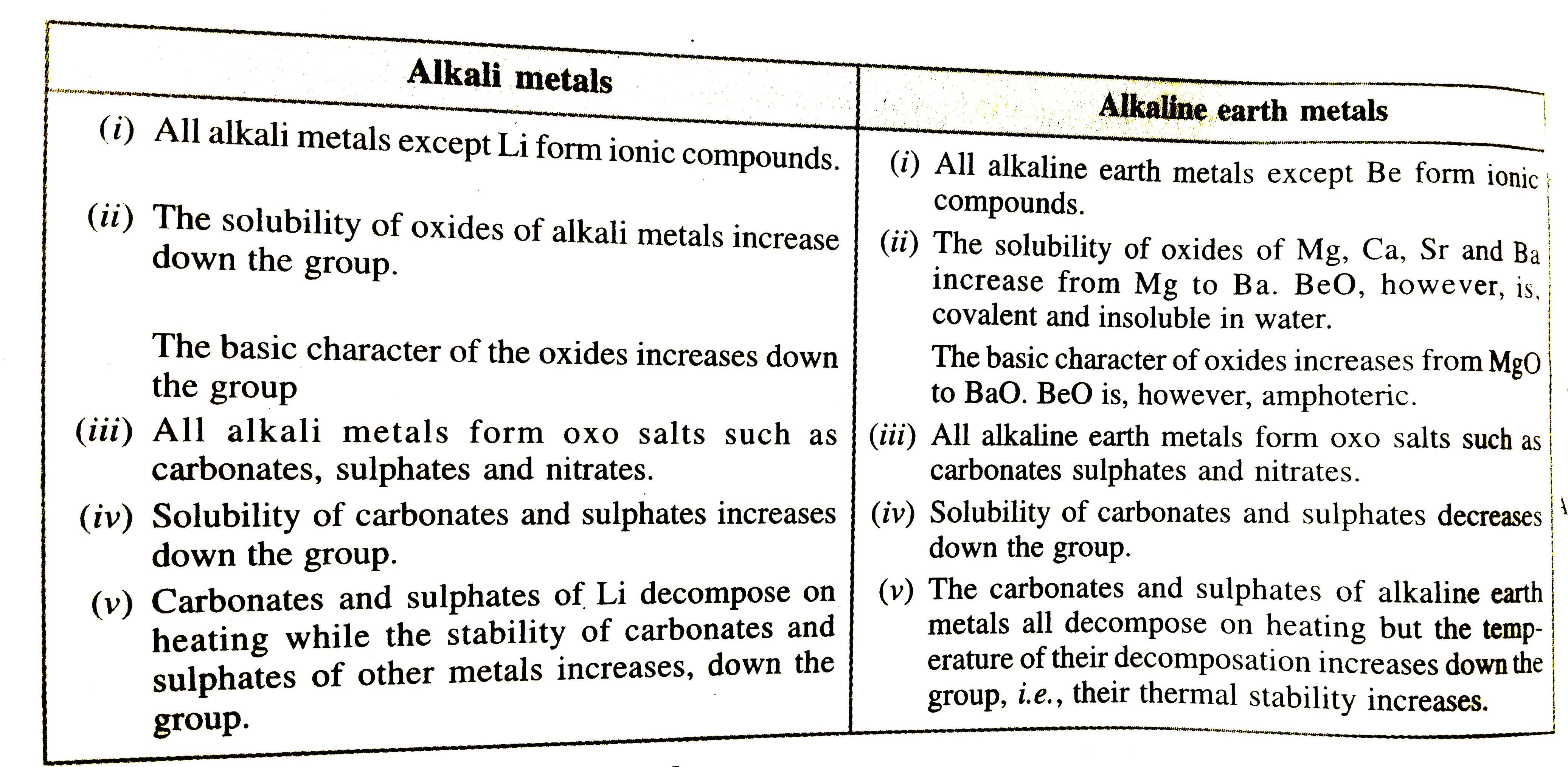Present a comparative account of the alkali and alkaline earth metals with respect to the following characteristics.
(a) Tendency to form ionic/covalent compounds (b) Nature of oxides and their solubility in water
(c) Formation of oxoslats
(d) Solubility of oxosalts
(e) Thermal stability of oxosalts
Topper's Solved these Questions
- BOOK - PRADEEPCHAPTER - S-BLOCK ELEMENTS (ALKALI AND ALKALINE EARTH METALS) EXERCISE - Additional Questions (Very Short Answer Questions) Group 1 Elements - Alkali Metals16videos
S-BLOCK ELEMENTS (ALKALI AND ALKALINE EARTH METALS)
- BOOK - PRADEEPCHAPTER - S-BLOCK ELEMENTS (ALKALI AND ALKALINE EARTH METALS) EXERCISE - Additional Questions (Very Short Answer Questions) Group 2 Elements - Alkaline Earth Metals17videos
S-BLOCK ELEMENTS (ALKALI AND ALKALINE EARTH METALS)
- BOOK - PRADEEPCHAPTER - S-BLOCK ELEMENTS (ALKALI AND ALKALINE EARTH METALS) EXERCISE - NCERT EXEMPLAR PROBLEMS WITH ANSWERS , HINTS AND SOLUTIONS (Assertion and Reason Type Questions)2videos
S-BLOCK ELEMENTS (ALKALI AND ALKALINE EARTH METALS)
- BOOK - PRADEEPCHAPTER - REDOX REACTIONS EXERCISE - Assertion reason type question16videos
REDOX REACTIONS
- BOOK - PRADEEPCHAPTER - SOLID STATE EXERCISE - Advanced problems19videos
SOLID STATE
Similar Questions
Present a comparative account of the alkali and alkaline earth metals with respect to the following characteristics.
(a) Tendency to form ionic/covalent compounds (b) Nature of oxides and their solubility in water
(c) Formation of oxoslats
(d) Solubility of oxosalts
(e) Thermal stability of oxosaltsView SolutionCompare the alkali metals and alkaline earth metals with respect to (a) ionisation enthalpy, (b) basicity of oxides and (c ) solubility of hydroxides.
View SolutionCompare the alkali metals and alkaline earth metals with respect to (a) ionisation enthalpy, (b) basicity of oxides and (c ) solubility of hydroxides.
View SolutionCompare the alkali metals and alkaline earth metals with respect to (a) ionisation enthalpy, (b) basicity of oxides and (c ) solubility of hydroxides.
View SolutionTwo elements 'P' and 'Q' belong to the same period of the modern periodic table and
are in Group-1 and Group-2 respectively. Compare their following characteristics in
tabular from:
(a) The number of electrons in their atoms
(b) The sizes of their atoms
(c) Their metallic characters
(d) Their tendencies to lose electrons
(e)The formula of their oxides
(f) The formula of their chloridesView SolutionCompare the solubility and thermal stability of the following compounds of the alkali metals with those of the alkaline earth metals.
(a) Nitrates
(b) Carbonates
(c) Sulphates.View SolutionTwo elements ‘A’ and 'B' belong to the 3rd period of Modern periodic table and are in group 2 and 13 respectively. Compare their following characteristics in tabular form:
(a) Number of electrons in their atoms (b) Size of their atoms (c) Their tendencies to lose electrons (d) The formula of their oxides (e) Their metallic character The formula of their chloridesView SolutionTwo elements 'P' and 'Q' belong to the same period of the modern periodic table and
are in Group-1 and Group-2 respectively. Compare their following characteristics in
tabular from:
(a) The number of electrons in their atoms
(b) The sizes of their atoms
(c) Their metallic characters
(d) Their tendencies to lose electrons
(e)The formula of their oxides
(f) The formula of their chloridesView SolutionCompare the solubility and thermal stability of the following compounds of the alkali metals with those of the alkaline earth metals. (a) Nitrates (b) Carbonates (c) Sulphates.
View SolutionCompare alkaline earth metals with alkali metals w.r.t (a) atomic and ionic size, (b) metallic bonds, ( c) melting points and (d) hardness.
View Solution


